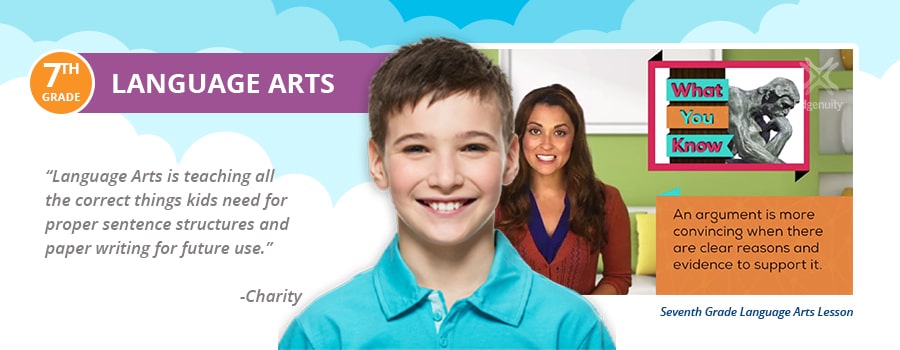Seventh Grade Language Arts Curriculum
In 7th grade language arts, students should be increasing their ability to analyze and synthesize information, strengthening their reading skills , and improving their writing proficiency.
On this page you will discover the key English language arts (ELA) concepts your 7th grader will need to know, learn more about the general 7th grade language arts objectives, and find out how Time4Learning’s seventh grade language arts curriculum helps homeschool families achieve their goals for this important year of education.
What Do 7th Graders Learn in Language Arts?
Seventh grade is a year of highly visible progress in reading, writing, and language arts. By the end of seventh grade, students should:
- Develop complex writing skills.
- Constructively critique their own and other’s writing.
- Apply punctuation, grammar, and syntax skills.
- Recognize and apply grade appropriate vocabulary.
- Read with fluency, with focus on comprehension.
- Compare books to their movie version and describe how the message is affected.
- Compare and contrast texts from different authors presenting the same topic.
- Write more in-depth research papers with citations and quotes from multiple sources.
The ideal curriculum will meet each of these 7th grade language arts standards while using multimedia and engaging projects to keep students motivated to learn.
Learn more about Time4Learning’s seventh grade language arts lesson plans below.
Reading Goals & Objectives for 7th grade
Middle schoolers are presented with increasingly complex texts in all subjects, so they must master reading skills that will bridge across all curriculum areas. A successful 7th grade language arts curriculum will focus on reading skills such as:
- Using strategies to construct the meaning of unfamiliar words
- Analyze elements and style of different genres of literature
- Use text evidence to analyze, infer, and synthesize ideas.
- Determining the theme of a text as well as the author’s purpose
- Giving an objective summary of a text
- Identifying and distinguishing between cause and effect in literature
Seventh Grade Writing Goals/Objectives
In the middle school years, students are learning how to adapt their written communication to the intended audience, task, or purpose. This involves many different skills including:
- Learning how to write an analytical argument and support it with claims and evidence
- Organizing informative/explanatory writing by definition, classification, cause and effect, comparison and contrast
- Developing topics with relevant content, language, and style
- Conducting short research projects to answer questions
- Quoting and paraphrasing information from sources
Time4Learning’s 7th grade language arts activities incorporate instruction, practice and assessment on each of these core writing objectives.
Seventh Grammar Goals/Objectives
Being able to communicate effectively in writing requires a mastery of grammar and mechanics. Practically, that translates into doing better in school, getting the jobs we seek, and clarifying our points of view. In seventh grade, grammar instruction focuses on concepts such as:
- Using prepositional phrases and clauses correctly
- Understanding and use of all parts of speech, including plural nouns, possessive nouns, verb tenses, adjectives, adverbs, prepositional phrases, and conjunctions
- Applying the rules of convention for capitalization and punctuation
- Recognition of simple, compound, complex, and compound-complex sentences to signal differing relationships among ideas.
Time4Learning’s 7th Grade Language Arts Scope and Sequence
The student will demonstrate knowledge by determining the meaning of synonyms from grade level appropriate vocabulary, by correctly choosing a given word or phrase that means the same thing, in reading activities that incorporate explicit instruction and application.
The student will demonstrate knowledge by determining the meaning of antonyms from grade level appropriate vocabulary, by correctly choosing a given word or phrase that means the opposite, in reading activities that incorporate explicit instruction and application.
The student will be able to analyze and determine the correct meaning of a word, based on the prefix of the root word or how the prefix is used in the context of a passage.
The student will be able to analyze and determine the correct meaning of a word, based on the suffix of the root word or how the suffix is used in the context of a passage.
The student will be able to identify and select the appropriate homophone or word that sounds the same, based on the context of a passage which fits the best meaning of the given word or phrase.
The student will be able to identify and analyze the author’s use of idioms, based on the context of a passage and how these expressions are used in literal and interpretative information.
The student will be able to identify and determine the meaning of unknown words, based on the understanding of Latin and Greek roots.
Use the reading comprehension process skills of summarizing, predicting, visualizing, questioning, and clarifying with extensive scaffolding and support, through think aloud prompts.
Use the reading comprehension process skills of summarizing, predicting, visualizing, questioning, and clarifying with scaffolding and support, through think aloud prompts.
Use the reading comprehension process skills of summarizing, predicting, visualizing, questioning, and clarifying to independently read and comprehend texts with minimal think aloud support.
Develop summaries, paraphrase, or synthesize information from two or more literary or expository texts.
Analyze and explain the impact of characters and settings within the plot of literary text(s), the exposition, and how relationships effect the central conflict which leads to the climax and resolution.
Identify the ways major and minor conflicts affect character’s actions by comparing and contrasting actions, setting(s), symbolism, and plot from various literary texts.
Identify, summarize, or explain the main idea(s) using the supporting details in an expository text.
Identify, summarize, or explain the main idea(s) or theme(s) using the supporting details and symbolism in a literary text.
Read, interpret and make predictions using charts, graphs, diagrams, maps or other graphic representations.
Identify and distinguish between cause and effect in expository and literary texts.
Identify and use knowledge of the author’s purpose by analyzing how the literary techniques of mood and tone affects author’s perspective and contributes to the comprehension of a literary or expository text.
Use knowledge, information, and ideas from literary texts, expository texts, or from multiple sources to make inferences about the text(s) (e.g., make inferences, draw conclusions, make generalizations, infer sequence of events, and infer a character’s feelings.)
Compare and contrast information and ideas within a text or between two or more texts (literary or expository), including metaphors and point of view.
Students will demonstrate knowledge of comprehension skills on grade level appropriate literary and expository passages, with questions that simulate a high-stakes assessment.
Through an exploratory activity, the student will acquire background information that will set the stage for the anchor piece, the play The Scarlet Pimpernel. The student will develop vocabulary through the use of a literature-based glossary and an interactive assessment activity that focuses on the use of a graphic organizer where the student matches words with their definitions. The student will also respond to a prewriting prompt.
The student will achieve comprehension by reading the play The Scarlet Pimpernel with emphasis on vocabulary and fluency. The student will be assessed on their comprehension of the literature selection by answering questions about drawing conclusions, mood, cause and effect, making inferences, characterization, sequence of events, supporting details, compare/contrast, characterization, and theme.
The student will use a variety of strategies to comprehend reading selections and be assessed on vocabulary contained in the literature selection. The student will analyze and evaluate the literature piece by responding to literary response and analysis prompts. Through a comprehension activity that incorporates direct instruction, a practice, and an assessment component, the student will focus on point of view. A reteach component provides a different instructional modality for students who need additional direct instruction on the point of view objective.
Through a series of writing activities that incorporate direct instruction, a practice, and an assessment component, the student will focus on relevant evidence in a persuasive composition as it relates to a review of a movie or play. The student will respond to prompts to write his or her own review of a play or a movie.
Through an exploratory activity, the student will acquire background information that will set the stage for the anchor piece, an excerpt from the realistic fiction novel Hush. The student will develop vocabulary through the use of a literature-based glossary and an interactive assessment activity that focuses on the correct usage of words within the context of a sentence or as a graphic representation. The student will also respond to a prewriting prompt.
The student will achieve comprehension by reading an excerpt from the realistic fiction novel Hush with emphasis on vocabulary and fluency. The student will be assessed on their comprehension of the literature selection by answering questions about main idea, making inferences, author’s purpose, summary, mood, characterization, character’s point of view, sequence of events, theme, and supporting details.
The student will use a variety of strategies to comprehend reading selections and be assessed on vocabulary contained in the literature selection. The student will analyze and evaluate the literature piece by responding to literary response and analysis prompts. Through a comprehension activity that incorporates direct instruction, a practice, and an assessment component, the student will focus on compare and contrast. A reteach component provides a different instructional modality for students who need additional direct instruction on the compare and contrast objective.
Through a series of writing activities that incorporate direct instruction, a practice, and an assessment component, the student will focus on personal narrative that includes memories of an event or an experience as it relates to a memoir. The student will respond to prompts to write a memoir of an event or experience of his or her own.
Through an exploratory activity, the student will acquire background information that will set the stage for the anchor piece, an excerpt from the action-adventure novel The Wreckers. The student will develop vocabulary through the use of a literature-based glossary and an interactive assessment activity that focuses on correctly identifying a vocabulary word with its definition. The student will also respond to a prewriting prompt.
The student will achieve comprehension by reading an excerpt from the action-adventure novel The Wreckers with emphasis on vocabulary and fluency. The student will be assessed on their comprehension of the literature selection by answering questions about characterization, drawing conclusions, mood, making inferences, figurative language, sequence, supporting details, cause and effect, author’s purpose, and summarizing.
The student will use a variety of strategies to comprehend reading selections and be assessed on vocabulary contained in the literature selection. The student will analyze and evaluate the literature piece by responding to literary response and analysis prompts. Through a comprehension activity that incorporates direct instruction, a practice, and an assessment component, the student will focus on how to tell the difference between conclusions that are based on fact and those that are based on opinions in the selection. A reteach component provides a different instructional modality for students who need additional direct instruction on the fact and opinion objective.
Through a series of writing activities that incorporate direct instruction, a practice, and an assessment component, the student will focus on writing a fictional narrative that develops a definite setting as it relates to a suspense story. The student will respond to a prompt to write a suspense story of his or her own.
Through an exploratory activity, the student will acquire background information that will set the stage for the anchor piece, an excerpt from the true story The Wright Brothers. The student will develop vocabulary through the use of a literature-based glossary and an interactive assessment activity that focuses on correctly identifying a vocabulary word with its definition. The student will also respond to a prewriting prompt.
The student will achieve comprehension by reading an excerpt from the true story The Wright Brothers: The Birth of Modern Aviation with emphasis on vocabulary and fluency. The student will be assessed on their comprehension of the literature selection by answering questions about cause and effect, themes, figurative language, sequence, making inferences, characterization, mood, recognizing main ideas, point of view, and author’s purpose.
The student will use a variety of strategies to comprehend reading selections and be assessed on vocabulary contained in the literature selection. The student will analyze and evaluate the literature piece by responding to literary response and analysis prompts. Through a comprehension activity that incorporates direct instruction, a practice, and an assessment component, the student will focus on identifying text that uses sequencing or other types of logical order in the selection. A reteach component provides a different instructional modality for students who need additional direct instruction on the sequence of events objective.
Through a series of writing activities that incorporate direct instruction, a practice, and an assessment component, the student will focus on writing a simple expository description of a real object, person, place, or event as it relates to a newspaper article. The student will respond to a prompt to write a newspaper article of his or her own.
Why Choose Time4Learning’s 7th Grade Language Arts Homeschool Curriculum?
Time4Learning’s 7th grade online homeschool curriculum helps students master each of the above reading, writing, and grammar skills plus so many more. The comprehensive collection of videos, multimedia activities, and interactive assessments ensures that student instruction is varied and engaging.
Learn more about our online seventh grade curriculum, designed to help your child learn and master their fundamental concepts.







